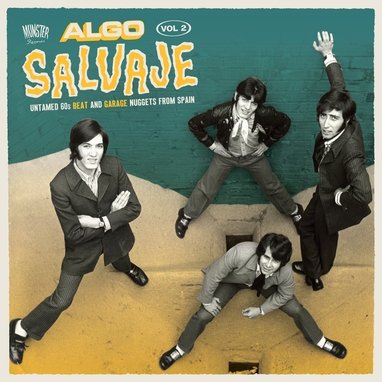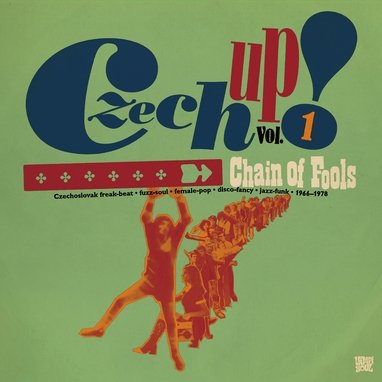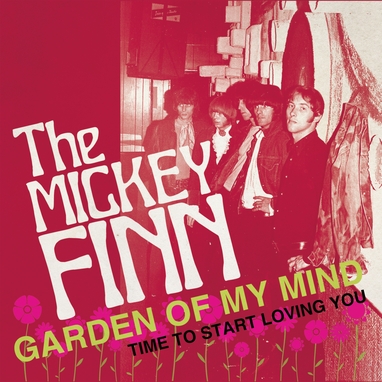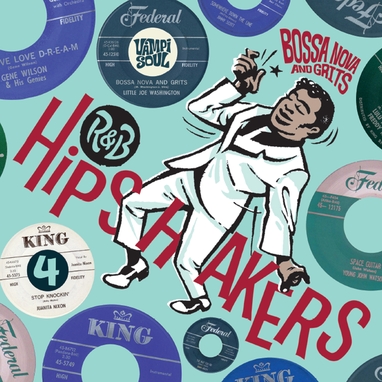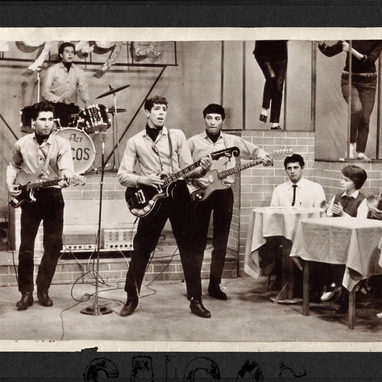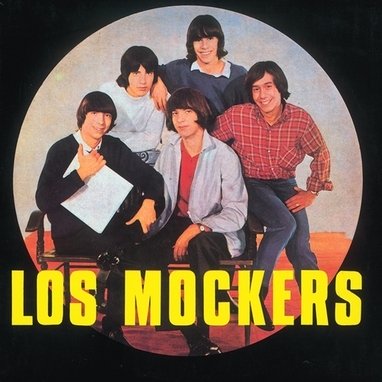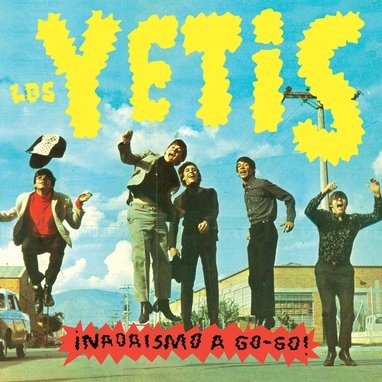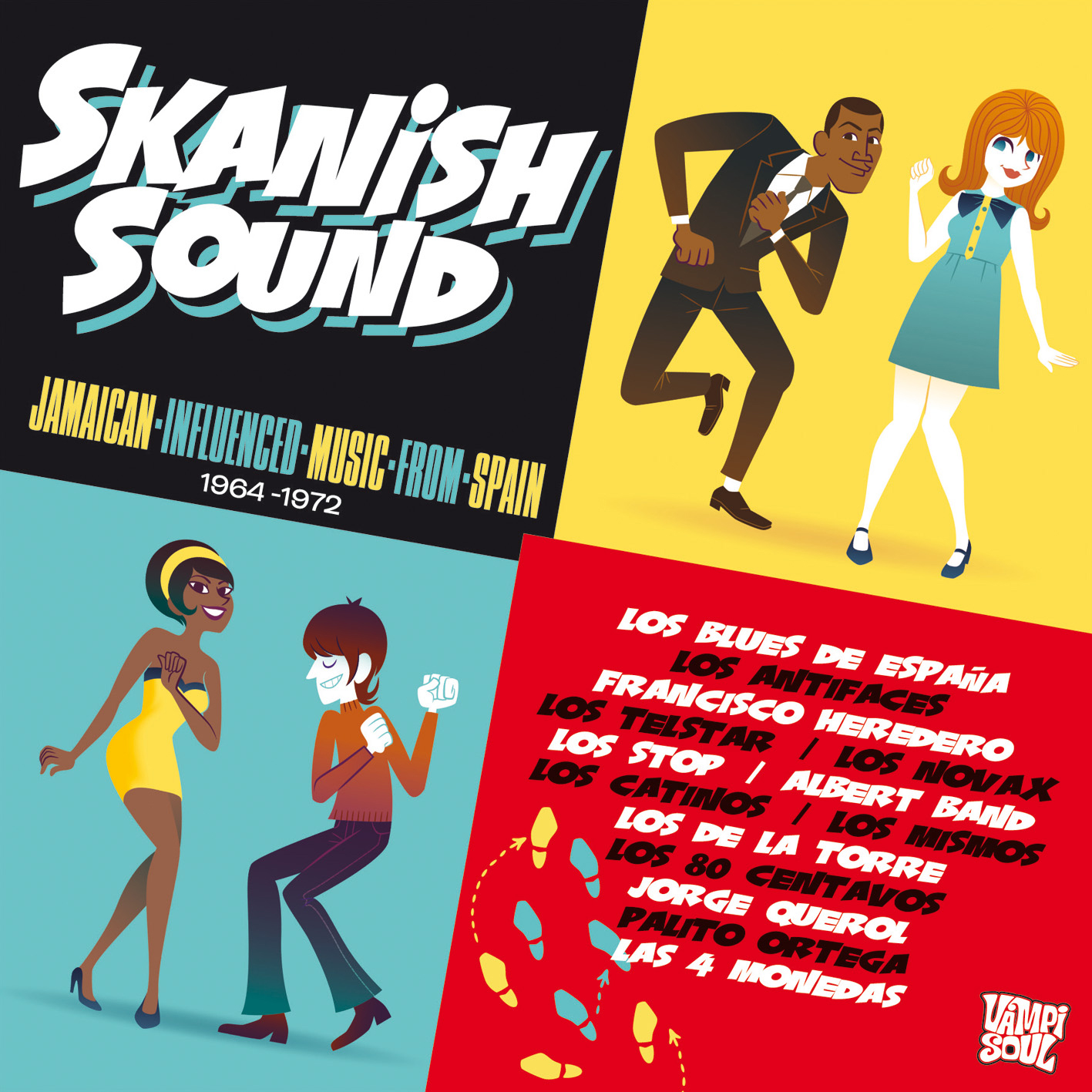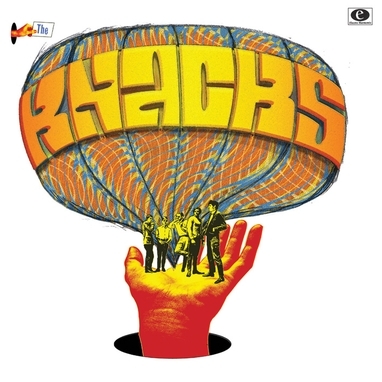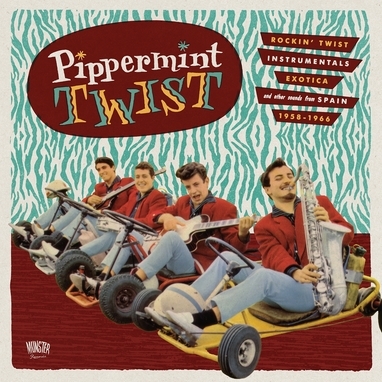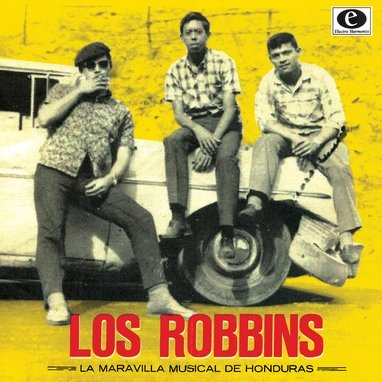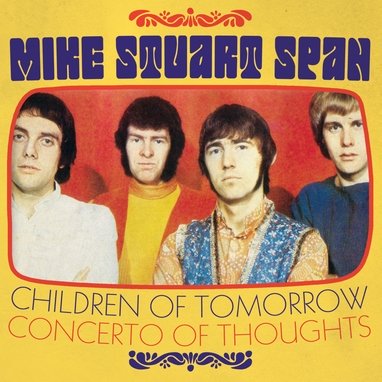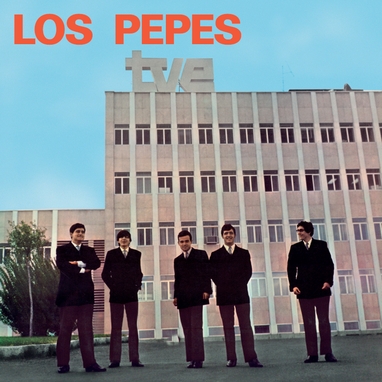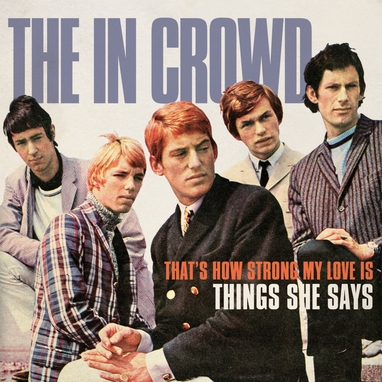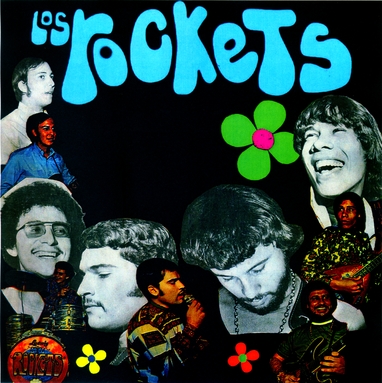VVAA
Algo Salvaje Vol 2
Munster
VVAA
Algo Salvaje Vol 2
The awaited second volume of our “Algo salvaje” series, featuring untamed 1960s beat and garage nuggets from Spain. “Algo salvaje” is the first legal anthology devoted to a rich period when hundreds of bands appeared all over Spain and, after paying attention to what their US and British contemporaries were doing, found their own way to vent their teenage rebellion through loud guitars. With amazing results! Many of the 28 tracks are reissued for the first time, including very hard-to-find records. Both formats include extensive notes by Vicente Fabuel featuring all the original record sleeves and artist photos.
Here we are again with the second volume of “Algo salvaje” (“Something Wild”). We haven’t had to wait long: here it comes, fast and furious, carrying the torch lit by the first volume. A festival of raw beats, direct and aggressive, mixed with understandable stylistic digressions, given the psychedelic transformation at the time. All are identifying marks of this second volume, a collection that should legitimize the Spanish garage-beat scene as one of the great musical (and social) offerings from a country that was stretching its limbs as much as it possibly could despite the restricting bonds of dictatorship. We return to those days to celebrate a wild, purely hedonistic, juvenile adventure (with few exceptions devoid of any professional sheen) which formed a musical offering capable of explaining to anyone today that, even subconsciously, in those dark days small trenches were being built with the aid of a fuzz pedal. If the radio and television of Spain were both systematically hogged by the friendliest and softest pop songs, this new beat brawl, forged and beaten into shape on the Bsides of singles, started a parallel culture which in turn generated an important underground scene, out of the spotlight of the ever-present censor. Whether they were city dwellers or country folk, university students or illiterates with only the most basic education, their musical cry had little to do with the studied social outbursts of the singer-songwriter, nor did it pertain to any specific alternative music scene. The most restless adolescents understood that the volatile social chemistry of those years demanded of them both flexibility and resource management. In other words, wide open ears with no restrictive earplugs of any kind: beat, rhythm & blues, rock & roll, Bo Diddley beats, folk-rock, the early scent of psychedelia… A local scene as modest then as it is categorical today, appears before our eyes: audacious kids that, even in that oppressive and unhealthy environment, saw no need to construct an adult, anti-establishment discourse and felt creatively free, not ever having to apologize for shouting “Soy así” (“That’s the way I am”), “Yo grito” (“I scream”) or “Diciendo no” (“Saying no”). It’s not hard to imagine the news passing from mouth to ear among young music fans in 1966, fascinated and driven to distraction when hearing, astonished, something as angry as ?Te esperaba’ by Los Pops, even after having heard the canonical version by The Animals. Dazzled, probably, for the rest of their days. A quarter of the material here shows the genre’s continued presence beyond 1968, sensitive and permeable to the new musical trends. And of course once again we find the omnipresent influence of the Liverpool sound and English beat in general… All of that shaken (and well stirred) with our own sense of identity to create an authentic mish-mash of a cocktail that today, fortunately, is recognized internationally, and which reveals to us the real starting point for a fair assessment of this scene: those uncertain times in the 60s in which a simple small-town boy decided, at least for a few energetic moments, not to bow down to anyone or anything. Vicente Fabuel
Productos relacionados
The awaited second volume of our “Algo salvaje” series, featuring untamed 1960s beat and garage nuggets from Spain. “Algo salvaje” is the first legal anthology devoted to a rich period when hundreds of bands appeared all over Spain and, after paying attention to what their US and British contemporaries were doing, found their own way to vent their teenage rebellion through loud guitars. With amazing results! Many of the 28 tracks are reissued for the first time, including very hard-to-find records. Both formats include extensive notes by Vicente Fabuel featuring all the original record sleeves and artist photos.
Here we are again with the second volume of “Algo salvaje” (“Something Wild”). We haven’t had to wait long: here it comes, fast and furious, carrying the torch lit by the first volume. A festival of raw beats, direct and aggressive, mixed with understandable stylistic digressions, given the psychedelic transformation at the time. All are identifying marks of this second volume, a collection that should legitimize the Spanish garage-beat scene as one of the great musical (and social) offerings from a country that was stretching its limbs as much as it possibly could despite the restricting bonds of dictatorship. We return to those days to celebrate a wild, purely hedonistic, juvenile adventure (with few exceptions devoid of any professional sheen) which formed a musical offering capable of explaining to anyone today that, even subconsciously, in those dark days small trenches were being built with the aid of a fuzz pedal. If the radio and television of Spain were both systematically hogged by the friendliest and softest pop songs, this new beat brawl, forged and beaten into shape on the Bsides of singles, started a parallel culture which in turn generated an important underground scene, out of the spotlight of the ever-present censor. Whether they were city dwellers or country folk, university students or illiterates with only the most basic education, their musical cry had little to do with the studied social outbursts of the singer-songwriter, nor did it pertain to any specific alternative music scene. The most restless adolescents understood that the volatile social chemistry of those years demanded of them both flexibility and resource management. In other words, wide open ears with no restrictive earplugs of any kind: beat, rhythm & blues, rock & roll, Bo Diddley beats, folk-rock, the early scent of psychedelia… A local scene as modest then as it is categorical today, appears before our eyes: audacious kids that, even in that oppressive and unhealthy environment, saw no need to construct an adult, anti-establishment discourse and felt creatively free, not ever having to apologize for shouting “Soy así” (“That’s the way I am”), “Yo grito” (“I scream”) or “Diciendo no” (“Saying no”). It’s not hard to imagine the news passing from mouth to ear among young music fans in 1966, fascinated and driven to distraction when hearing, astonished, something as angry as ?Te esperaba’ by Los Pops, even after having heard the canonical version by The Animals. Dazzled, probably, for the rest of their days. A quarter of the material here shows the genre’s continued presence beyond 1968, sensitive and permeable to the new musical trends. And of course once again we find the omnipresent influence of the Liverpool sound and English beat in general… All of that shaken (and well stirred) with our own sense of identity to create an authentic mish-mash of a cocktail that today, fortunately, is recognized internationally, and which reveals to us the real starting point for a fair assessment of this scene: those uncertain times in the 60s in which a simple small-town boy decided, at least for a few energetic moments, not to bow down to anyone or anything. Vicente Fabuel
Productos relacionados
Algo Salvaje Vol 2
The awaited second volume of our “Algo salvaje” series, featuring untamed 1960s beat and garage nuggets from Spain. “Algo salvaje” is the first legal anthology devoted to a rich period when hundreds of bands appeared all over Spain and, after paying attention to what their US and British contemporaries were doing, found their own way to vent their teenage rebellion through loud guitars. With amazing results! Many of the 28 tracks are reissued for the first time, including very hard-to-find records. Both formats include extensive notes by Vicente Fabuel featuring all the original record sleeves and artist photos.
Here we are again with the second volume of “Algo salvaje” (“Something Wild”). We haven’t had to wait long: here it comes, fast and furious, carrying the torch lit by the first volume. A festival of raw beats, direct and aggressive, mixed with understandable stylistic digressions, given the psychedelic transformation at the time. All are identifying marks of this second volume, a collection that should legitimize the Spanish garage-beat scene as one of the great musical (and social) offerings from a country that was stretching its limbs as much as it possibly could despite the restricting bonds of dictatorship. We return to those days to celebrate a wild, purely hedonistic, juvenile adventure (with few exceptions devoid of any professional sheen) which formed a musical offering capable of explaining to anyone today that, even subconsciously, in those dark days small trenches were being built with the aid of a fuzz pedal. If the radio and television of Spain were both systematically hogged by the friendliest and softest pop songs, this new beat brawl, forged and beaten into shape on the Bsides of singles, started a parallel culture which in turn generated an important underground scene, out of the spotlight of the ever-present censor. Whether they were city dwellers or country folk, university students or illiterates with only the most basic education, their musical cry had little to do with the studied social outbursts of the singer-songwriter, nor did it pertain to any specific alternative music scene. The most restless adolescents understood that the volatile social chemistry of those years demanded of them both flexibility and resource management. In other words, wide open ears with no restrictive earplugs of any kind: beat, rhythm & blues, rock & roll, Bo Diddley beats, folk-rock, the early scent of psychedelia… A local scene as modest then as it is categorical today, appears before our eyes: audacious kids that, even in that oppressive and unhealthy environment, saw no need to construct an adult, anti-establishment discourse and felt creatively free, not ever having to apologize for shouting “Soy así” (“That’s the way I am”), “Yo grito” (“I scream”) or “Diciendo no” (“Saying no”). It’s not hard to imagine the news passing from mouth to ear among young music fans in 1966, fascinated and driven to distraction when hearing, astonished, something as angry as ?Te esperaba’ by Los Pops, even after having heard the canonical version by The Animals. Dazzled, probably, for the rest of their days. A quarter of the material here shows the genre’s continued presence beyond 1968, sensitive and permeable to the new musical trends. And of course once again we find the omnipresent influence of the Liverpool sound and English beat in general… All of that shaken (and well stirred) with our own sense of identity to create an authentic mish-mash of a cocktail that today, fortunately, is recognized internationally, and which reveals to us the real starting point for a fair assessment of this scene: those uncertain times in the 60s in which a simple small-town boy decided, at least for a few energetic moments, not to bow down to anyone or anything. Vicente Fabuel
The awaited second volume of our “Algo salvaje” series, featuring untamed 1960s beat and garage nuggets from Spain. “Algo salvaje” is the first legal anthology devoted to a rich period when hundreds of bands appeared all over Spain and, after paying attention to what their US and British contemporaries were doing, found their own way to vent their teenage rebellion through loud guitars. With amazing results! Many of the 28 tracks are reissued for the first time, including very hard-to-find records. Both formats include extensive notes by Vicente Fabuel featuring all the original record sleeves and artist photos.
Here we are again with the second volume of “Algo salvaje” (“Something Wild”). We haven’t had to wait long: here it comes, fast and furious, carrying the torch lit by the first volume. A festival of raw beats, direct and aggressive, mixed with understandable stylistic digressions, given the psychedelic transformation at the time. All are identifying marks of this second volume, a collection that should legitimize the Spanish garage-beat scene as one of the great musical (and social) offerings from a country that was stretching its limbs as much as it possibly could despite the restricting bonds of dictatorship. We return to those days to celebrate a wild, purely hedonistic, juvenile adventure (with few exceptions devoid of any professional sheen) which formed a musical offering capable of explaining to anyone today that, even subconsciously, in those dark days small trenches were being built with the aid of a fuzz pedal. If the radio and television of Spain were both systematically hogged by the friendliest and softest pop songs, this new beat brawl, forged and beaten into shape on the Bsides of singles, started a parallel culture which in turn generated an important underground scene, out of the spotlight of the ever-present censor. Whether they were city dwellers or country folk, university students or illiterates with only the most basic education, their musical cry had little to do with the studied social outbursts of the singer-songwriter, nor did it pertain to any specific alternative music scene. The most restless adolescents understood that the volatile social chemistry of those years demanded of them both flexibility and resource management. In other words, wide open ears with no restrictive earplugs of any kind: beat, rhythm & blues, rock & roll, Bo Diddley beats, folk-rock, the early scent of psychedelia… A local scene as modest then as it is categorical today, appears before our eyes: audacious kids that, even in that oppressive and unhealthy environment, saw no need to construct an adult, anti-establishment discourse and felt creatively free, not ever having to apologize for shouting “Soy así” (“That’s the way I am”), “Yo grito” (“I scream”) or “Diciendo no” (“Saying no”). It’s not hard to imagine the news passing from mouth to ear among young music fans in 1966, fascinated and driven to distraction when hearing, astonished, something as angry as ?Te esperaba’ by Los Pops, even after having heard the canonical version by The Animals. Dazzled, probably, for the rest of their days. A quarter of the material here shows the genre’s continued presence beyond 1968, sensitive and permeable to the new musical trends. And of course once again we find the omnipresent influence of the Liverpool sound and English beat in general… All of that shaken (and well stirred) with our own sense of identity to create an authentic mish-mash of a cocktail that today, fortunately, is recognized internationally, and which reveals to us the real starting point for a fair assessment of this scene: those uncertain times in the 60s in which a simple small-town boy decided, at least for a few energetic moments, not to bow down to anyone or anything. Vicente Fabuel

